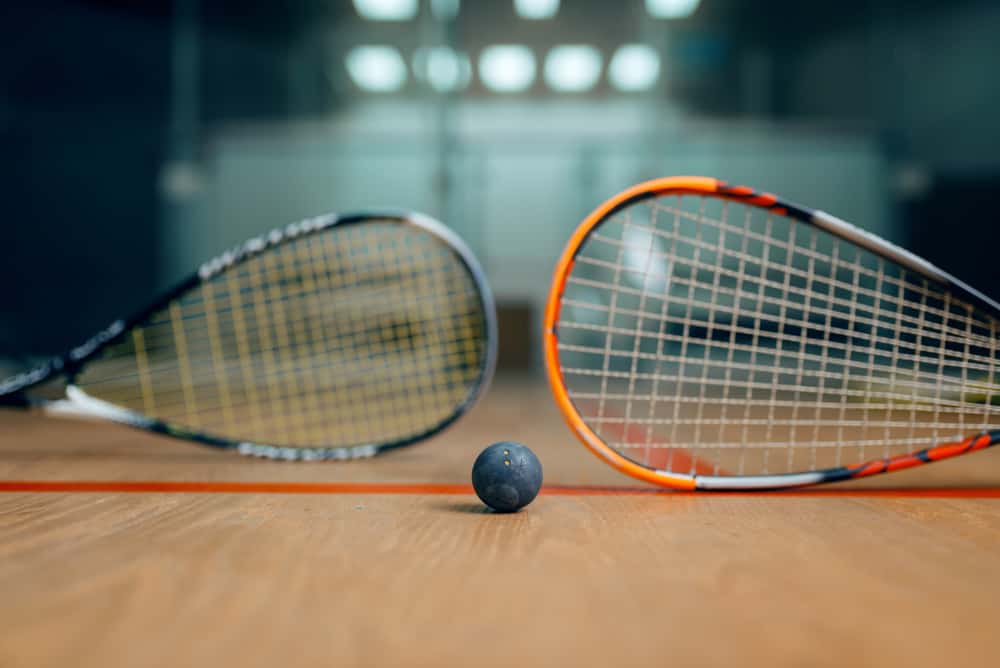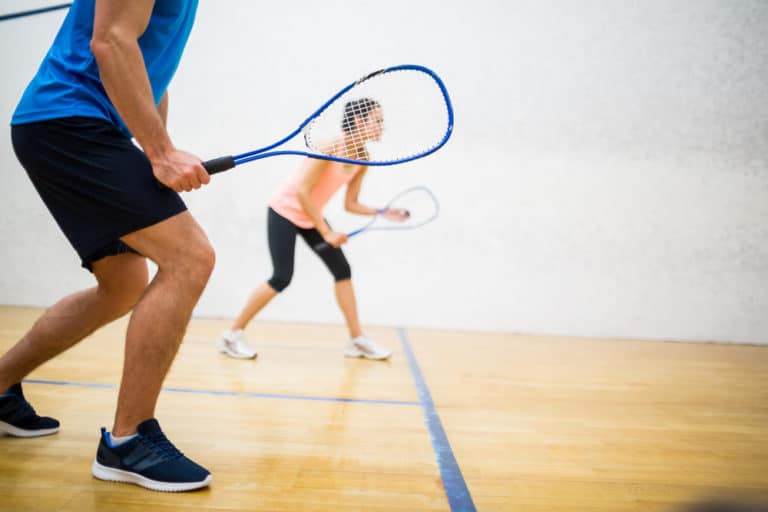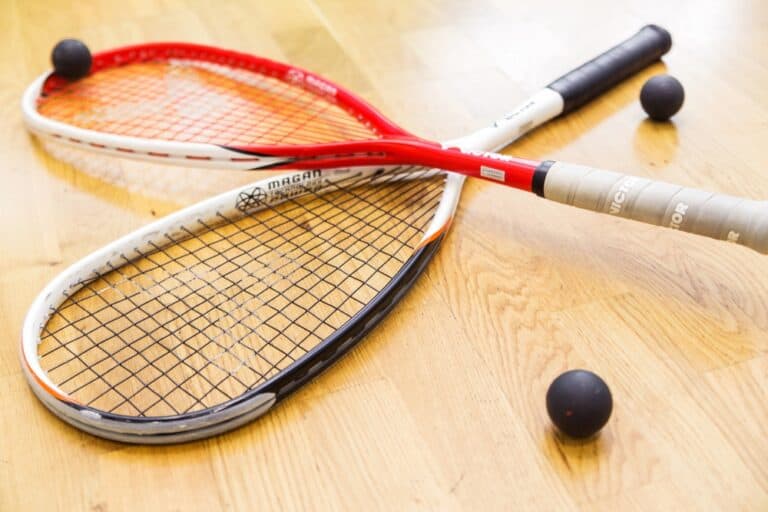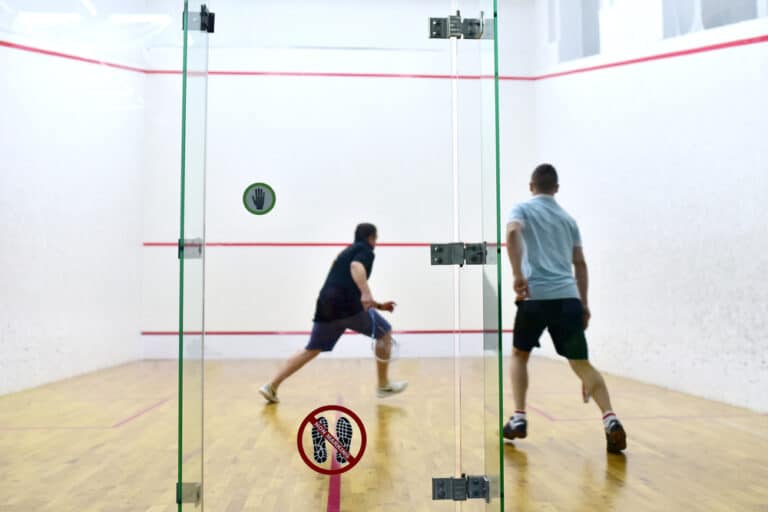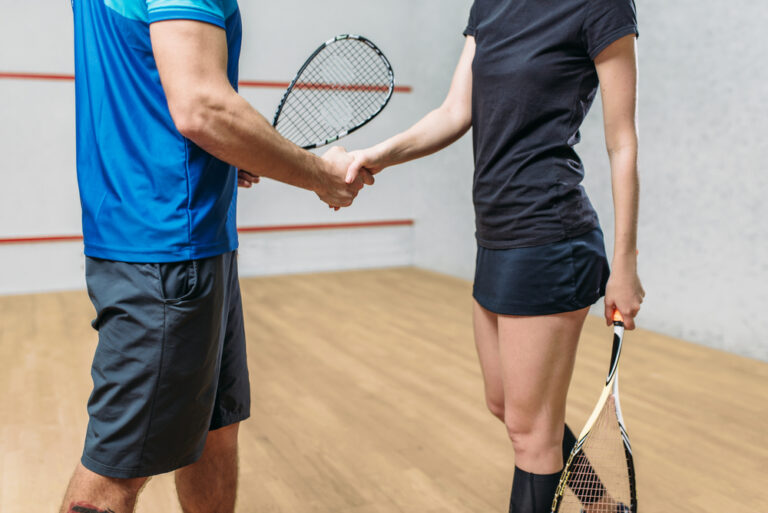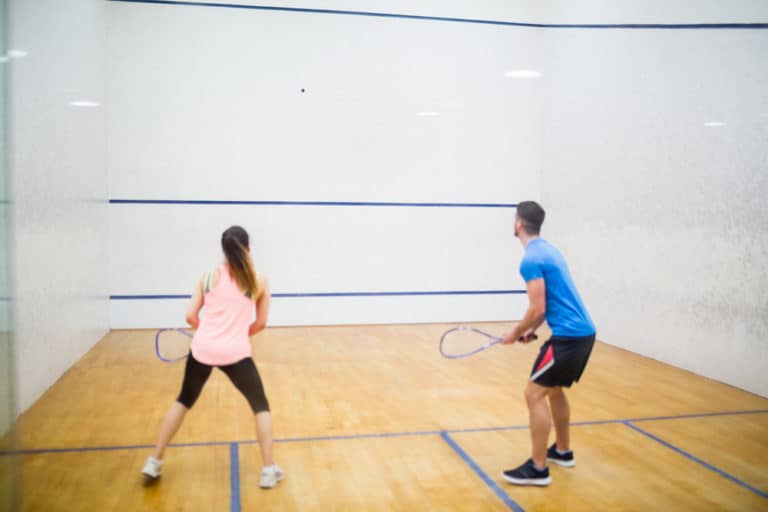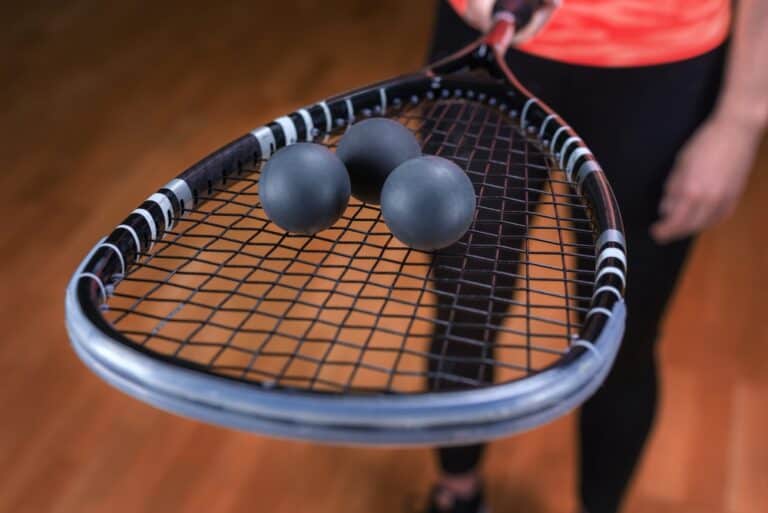Can You Play Squash On A Tennis Court?
There are plenty of similarities between squash and tennis, but the courts and rackets are definitely not similar. Both sports require having a racket in hand and the serving of a ball. Squash and tennis also have many of the same playing techniques. But that is basically where the similarities end. With several similarities and so many differences, can you play squash on a tennis court?
The requirements of the two sports are so different that you can’t play squash on a tennis court. Not only is squash mainly played in an enclosed area, but the materials that are used to construct a squash court are also vastly different from those used to build a tennis court. They’re not similar.
The court is often seen as the primary difference between squash and tennis, but this isn’t the only difference that will determine if it is possible to play squash on a tennis court or not. Along with the court, we should also consider the type of ball used in each sport and the different play styles. Let’s compare the elements that make it inefficient to play squash on a tennis court.
The Main Differences Between A Squash Court And Tennis Court
There are a few major construction differences between a squash court and a tennis court. These differences mean that the two courts cannot be used interchangeably since the game’s rules and equipment should be changed completely to switch courts.
Squash Courts
Squash is played in an enclosed court, where players can use the walls to their advantage. Squash courts consist of a floor and four walls, although not all squash courts use the same materials to construct their walls.
- A squash court is an enclosed space that consists of a front wall, a back wall, and two side walls with an elevated roof. Depending on the style of play and the rules of the particular match, players may use any of the walls to their advantage. For example, a player driving a ball from one of the side walls to the front wall is a perfectly valid move.
- The floor of a squash court can consist of any of the following materials: Hardwood, Plywood, Wooden Sleepers, Rubber, or Concrete. These materials all have their particular advantages and disadvantages. Some allow for more bounce than others; some of them are more slippery and require special shoes.
- The front wall panels of the court consist of steel, wooden frames, drywall, or plywood, with foam insulation to make them fire-resistant and soundproof. The tin (a line on the front wall that serves a similar role to the net in tennis) is constructed out of metal.
The front wall panel is usually constructed out of either steel frames or wooden frames, and these materials are also used to build the part of the front wall that is played on. The rest of the front wall is made out of drywall or plywood because of the materials’ price, which is considerably lower.
- Like the front wall, the side wall panels are also constructed using steel, wooden frames, drywall, or plywood. The sidewalls also have foam insulation to make the court fire-resistant and soundproof.
- The back wall is made of tempered glass that’s strong enough to resist shattering and cracking. The tempered glass is used to make both the wall and the door. There are also squash courts that have a back wall made out of the same combinations of plywood or drywall as the side walls, but these are not as common.
- Most squash courts are 32 feet long and 21 feet wide.
- The layout of the squash court is arranged to allow for players to hit the ball from high to low, which is the typical style of shot played in squash.
Tennis Courts
Tennis courts can vary in the way the courts’ surfaces are constructed. There are four primary surface materials that are popularly used for tennis courts, namely grass, clay, hard acrylic, and artificial grass.
- The dimensions of tennis courts are 78 feet long and 27 to 36 feet wide. The width depends on whether it is a singles or a doubles match. Doubles matches obviously require a wider court. These dimensions are considerably larger than those of a squash court.
- The service line is 21 feet from the net on both sides of the court.
- Tennis courts are usually kept open and unobstructed.
- Tennis has a net in the center of the court. The net divides the court into two equals, one for each player or team.
- In tennis, one player volleys the ball over the net to the other player. It is impossible to play the ball off of walls since there aren’t any walls, and if the ball travels too far to the sides, it’s considered an out.
- In tennis, your swing path is from low to high. The unobstructed nature of a tennis court is ideal for this type of shot.
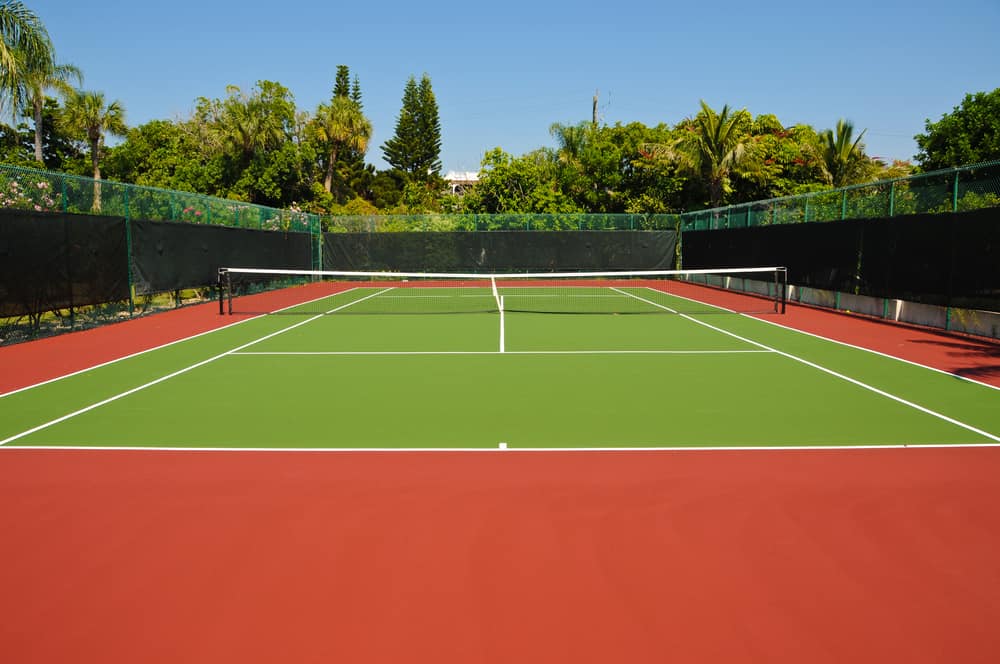
Adapted Outdoor Squash Court
We can now clearly see that the two courts are incompatible in every way. But there is a worldwide movement towards outdoor squash, where you take a space that you have and build a type of squash court around that.
Even though it is not an ideal space for playing squash the way it should be played, it is effective for bringing squash to underprivileged or poor communities that wouldn’t have had the chance to learn the sport in any other way.
Outdoor squash courts do not have a specific size. They can differ drastically from one another, depending on how they are adapted for a particular community. Neither will they look the same because these courts are built out of whatever a community has available for the construction of a squash court.
Some outdoor squash courts won’t even be totally enclosed like a standard squash court, which is why you can’t play squash according to the standard rules of squash on these courts. They are mainly there to make squash accessible to communities and countries where it would have otherwise been discarded as a sport that is not adaptable to that particular region.
- Most of these courts are not enclosed spaces. These adapted courts will all have a front wall, and some of them still have the two side walls. Most of them don’t have a back wall at all.
- The floor is different from a regular squash court, which will affect the bounce of the ball differently. It isn’t constructed out of wood or rubber as most regulated squash courts are. In fact, more often than not, the floor is simply whatever the ground was in the first place, whether that’s dirt, grass, cement, or any other material.
Similarities Between Squash And Tennis Courts
There is one main similarity between a squash court and a tennis court, which is the lines that are used to mark the courts to indicate where play is allowed and where players are positioned.
Both courts have a front line and a half-court line. These lines form three boxes on each court. The left-hand and right-hand boxes are service boxes, indicating where the players stand to serve the ball.
Apart from the lines, there are no fundamental similarities between a squash court and a tennis court.
Reasons Why You Cannot Play Squash On A Tennis Court
One of the main rules of squash is that the players can use all four walls to their advantage, and the ball is allowed to be played from all four walls. This fact alone should make the question of whether you can play squash on a tennis court irrelevant.
Another main difference that will affect your game if you attempt to play squash on a tennis court is the ball. Not only are the balls different, but the two balls also react differently to their surroundings and environments. Therefore you cannot expect the squash ball to act as it would when you play it off of the squash court walls.
Squash Balls
Squash balls are smaller than tennis balls. They are made out of a stiff rubber, which must be warmed up before the match starts, usually by playing some warm-up shots.
- Squash balls are hollow inside, but they consist of only rubber and don’t have a felt outer layer.
- A squash ball weighs between 23 and 25 grams.
- The ball measures between 39.5 and 40.5 mm (around 1.56 to 1.59 inches) in size.
- The squash ball is heated through the air inside the core of the hollow ball. Once the ball is warm and the pressure increases because of the heat, the ball becomes bouncier and more playable.
- Due to the size of the ball, it is recommended that novice players play with eye protection because of the velocity that squash balls can travel. Many injuries have occurred from balls that connected with a player’s eye.
Tennis Balls
Tennis balls are also hollow rubber balls, just like squash balls, but that is where the similarities end. They are manufactured differently, and due to the size of the balls, they move differently from squash balls.
- A tennis ball measures between 2.57 and 2.70 inches (6.54 to 6.86 cm) in diameter.
- Tennis balls weigh between 1.975 and 2.095 ounces (56 to 59.4 grams).
- The rubber inner balls get covered with felt. This felt outer layer helps the ball to react in a certain way when it connects with the racket.
- The tennis ball is designed in such a way that it is easy to see and moves with stability and power.
The Origins Of Squash And Tennis, And Their Impact On The Courts
Contrary to what people think, squash didn’t originate as an alternative version of tennis as we know it today. Though tennis is a few centuries older than squash, both squash and modern tennis originated from a much older sport called “real tennis.”
Tennis was developed much earlier than squash. Before squash, there was a sport called “racquets” that was created as a more straightforward adaptation of real tennis. Racquets simply involved a racquet (the older English style spelling) and a ball that was hit against one or two walls.
The racquet was a tennis bat that was stretched, and the ball was almost the same size and weight as a golf ball, made out of wound cloth. Racquets was played outdoors, but they soon migrated into indoor structures and courts due to England’s cold tempestuous weather.
The Royal Artillery was the first to build a covered racquets court in 1830 at the Woolwich depot. The Marylebone Cricket Club at Lords soon followed; they built a covered court in 1844 next to their real tennis court.
At this time, racquets started to bloom, and the concept of this game could soon be found around the world. However, to understand squash and how it originated, there is one more aspect that you need to understand. There was another ball and wall game that was also very popular in its time.
“Five Fingers of the Hand” was a traditional handball game and very similar to racquets, but it was played without rackets. Based on Five Fingers, rugby schools created another variant called “rugby five.” Rugby five had a court design of twenty-eight feet by eighteen feet, with side walls that sloped towards a back wall and a tin on the front wall.
We can now see where squash became the sport we know and love. The combined inspiration of these two games is how squash evolved. The elite English boys school, Harrow School, was the first to combine racquets and rugby five. The only technology that still needed to catch up was the ability to make rubber balls, to change this sport from the hard balls that were used to play racquets.
The moment the rubber balls came into play, the Harrow boys soon preferred the hollow rubber ball that was a bit larger than the hard racquet ball and slower to play with while playing racquets. This became a version of racquets called “baby racquets,” “soft racquets,” or simply “softer.” This new version, called baby racquets, was very popular among the Harrow boys.
Harrow School opened new courts for both Racquets and Rugby Five on 20 January 1865. However, not all courts were received with the same preference since the boys loved to play on the racquets courts while the rugby five courts were most often overlooked.
However, the boys soon realized that they could take their version of racquets, “baby racquets,” with the soft balls, to the Rugby Five courts and play on these courts. This became the game that is now known all over the world as squash.
Conclusion
There are significant differences between squash and tennis that make it difficult to play squash on a tennis court. Though there are some similarities, this will not be enough to make it possible to play on the courts interchangeably. The only way to make this a reality is to adapt a tennis court completely, enclose it, and give it side walls.
References
- https://www.si.com/tennis/2015/10/14/tennis-balls-atp-wta-matches
- https://www.head.com/en/squash/squash-how-tos/how-to-choose-the-right-squash-ball
- https://psaworldtour.com/news/view/3939/squash-balls-explained
- https://www.reddit.com/r/squash/comments/4qmgsp/tennis_players_new_to_squash/
- https://www.reddit.com/r/squash/wiki/squash_vs/
- https://www.masterclass.com/articles/types-of-tennis-courts
- https://www.britannica.com/sports/squash-rackets#ref887983
- https://www.youtube.com/watch?v=MB964lrqMHM
- https://www.youtube.com/watch?v=clBiBzvvwR8
- https://www.reddit.com/r/squash/comments/66emhi/different_types_of_squash_courts/
- https://www.reddit.com/r/tennis/comments/nat14c/court_surfaces_in_your_region/
- https://www.reddit.com/r/squash/comments/qsrwld/outdoor_squash_on_a_steel_court_in_nyc/

